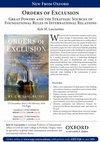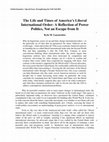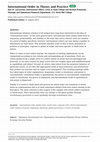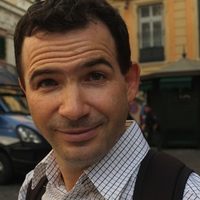Books by Kyle Lascurettes

Oxford University Press, 2020
When and why do powerful countries seek to enact major changes to international order, the broad ... more When and why do powerful countries seek to enact major changes to international order, the broad set of rules that guide behavior in world politics? Prior studies have focused on how the origins of orders have been consensus-driven and inclusive. By contrast, Kyle M. Lascurettes argues in Orders of Exclusion that the propelling motivation for great power order building has typically been exclusionary. Great powers pursue fundamental changes to order when they perceive a major new threat on the horizon, be it another powerful state or a foreboding ideological movement. The goal of foundational rule writing in international relations, then, is blocking a threatening entity from amassing further influence, a motive Lascurettes illustrates at work across more than three hundred years of history. Far from falling outside of the bounds of traditional statecraft, order building is the continuation of power politics by other means.
Papers by Kyle Lascurettes
Oxford University Press eBooks, May 7, 2020
Foreign Policy & International Relations, Orders of Exclusion, Feb 28, 2020

Orders of Exclusion, 2020
Chapter 1 (“Power Politics and International Order”) establishes a number of puzzles about global... more Chapter 1 (“Power Politics and International Order”) establishes a number of puzzles about global order more generally, and about the contemporary liberal international order more specifically. It explains why current commentary and scholarship have been insufficient for adequately addressing these puzzles, and then introduces a new argument—ordering-to-exclude theory—that is at the heart of the book. The current liberal international order, so revered by order optimists, is not as universally admired or as durable as many commentators believe. Ordering-to-exclude theory helps make sense of these discrepancies by pointing out the striking continuities behind the origins of past orders and those of the contemporary liberal international order. The chapter concludes by outlining the rest of the book’s structure and content and setting the stage for what is to come.

Orders of Exclusion, 2020
Chapter 3 (“A Theory of Exclusion”) develops the primary theoretical argument of the book. In bri... more Chapter 3 (“A Theory of Exclusion”) develops the primary theoretical argument of the book. In brief, it argues that actors seek to enact order principles to target and weaken entities they believe threaten their future security and enduring primacy. The larger and more immediate the threat, the more likely dominant actors are to pursue significant change to foundational order principles. The chapter first details this core logic of the ordering-to-exclude theory before developing important extensions of and refinements to the argument. Second, it introduces three viable alternative explanations for dominant actor order preferences and deduces testable hypotheses for each that can be evaluated alongside and against ordering-to-exclude theory. Finally, it discusses the research methods that inform the subsequent empirical chapters of the book and previews the structure that each of the nine case studies will take.

Chapter 4 (“Order in the Age of Great Power Politics”) assesses the first three cases of order ch... more Chapter 4 (“Order in the Age of Great Power Politics”) assesses the first three cases of order change opportunity. In two of these instances—the Westphalian settlements after the Thirty Years’ War in 1648 and the peace of Utrecht following the War of the Spanish Succession in 1713—the great power victors of these conflicts seized their opportunity to reshape order, while in one—the end of the Seven Years’ War in 1763—they did not. The chapter demonstrates that the logic of excluding introduced in chapter 3 best explains dominant-actors’ preferences and behaviors in these moments. When these states perceived no major threats on the horizon—in 1763—they were content to focus on the particularities of the recent war and its peace settlement rather than recasting larger order principles. But in the presence of looming threatening forces, the dominant actors of 1648 and 1713 sought larger and more fundamental order changes that went far beyond the particular issues of the day.

While the previous chapter chronicled the origins of the Cold War, chapter 8 (“Consolidating the ... more While the previous chapter chronicled the origins of the Cold War, chapter 8 (“Consolidating the Liberal International Order”) considers its ending. It focuses in particular on the principal security component of Western order during the Cold War’s endgame, NATO. In contrast to the extraordinary transformations after World War II, the pivotal changes in international power and influence that took place between the 1989 and 1991 did not correspond with matching changes in American order preferences or, more importantly, in order outcomes. Instead, US leaders ultimately chose to stick with existing principles, maintaining continuity of the Western order in the transition from the Cold War to a post–Cold War international system. We can account for this continuity, this chapter argues, by assessing American perceptions of the lack of new any new threatening entities or forces during this critical period.

In this paper I argue that the American leaders of the twentieth century came to prefer, advocate... more In this paper I argue that the American leaders of the twentieth century came to prefer, advocate and enact the distinct vision of order they did based on the same basic impulses that motivated the European statesmen most often associated with the age of great power politics. And whereas previous scholarship has highlighted the inclusive nature of international order, I posit that the motivations for order building at important historical junctures have most often been exclusionary. Specifically, hegemonic powers are most likely to reshape the foundational rules and institutions of world politics when they perceive a major and rising threat to their security and enduring primacy. I demonstrate the power of this exclusionary logic through an analysis of the American order-building project at three critical moments in the twentieth century: 1919, 1945, and 1989. Overall, I conclude that the degree to which the American-led order represents a clean break from the past has heretofore be...
How do we account for the vision of international order the American delegation pursued at the Pa... more How do we account for the vision of international order the American delegation pursued at the Paris Peace Conference after World War I, manifested most concretely in the Covenant of the League of Nations that was written by avowed liberal internationalist Woodrow Wilson? The dominant inclusive narrative of order construction in 1919 emphasizes America’s liberal institutions at home coupled with its president’s progressive ideals and sense of ideological mission in world affairs. By contrast, chapter 6 (“The Wilsonian Order Project”) argues that the new ideological threat posed by radical socialism after the Bolshevik Revolution in late 1917 actually played the most critical role in shaping the order preferences of Wilson and his principal advisers both before and during the Paris Peace Conference.
Chapter 9 (“The Future of Order”) reviews the empirical findings of the book and discusses their ... more Chapter 9 (“The Future of Order”) reviews the empirical findings of the book and discusses their implications for the study of international relations. It then leverages these findings to address the two most important questions for international order in the twenty-first century: In the near term, what changes to the existing liberal order will the United States advocate as it continues to decline in relative power? And in the long term, what is its projected hegemonic successor, China, likely to do with the existing order when it finds itself in a position to fundamentally recast its underlying principles?

Oxford Research Encyclopedia of International Studies, 2021
International relations scholars of all stripes have long been interested in the idea of “interna... more International relations scholars of all stripes have long been interested in the idea of “international order.” At the most general level, international order entails some level of regularity, predictability, and stability in the ways that actors interact with one another. At a level of higher specificity, however, international orders can vary along a number of dimensions (or fault lines). This includes whether order is thin or thick, premised on position or principles, regional or global in scope, and issue specific or multi-issue in nature. When it comes to how orders emerge, the majority of existing explanations can be categorized according to two criteria and corresponding set of questions. First, are orders produced by a single actor or a select subset of actors that are privileged and powerful, or are they created by many actors that are roughly equal and undifferentiated in capabilities and status? Second, do orders come about from the purposive behavior of particular actors...

Orders of Exclusion, 2020
Chapter 7 (“Birthing the Liberal International Order”) focuses on the American order project afte... more Chapter 7 (“Birthing the Liberal International Order”) focuses on the American order project after the Second World War. It argues that there were actually two distinct American visions for order in the 1940s, a universalist global order vision—manifested in the United Nations system—and a smaller Western order vision—comprised of the Bretton Woods economic and NATO security systems. Observers often posit that these layers were complementary, representing an evolving but not contradictory strategy by the United States to build an inclusive and multilayered international order. By contrast, this chapter argues that this transition from global to Western order can be best explained by American leaders’ shifting threat perceptions during this critical period. While they began with a more inclusive global order vision, they soon shifted to a more exclusive and adversarial Western order idea as they became increasingly wary of the extraordinary threat posed by their former wartime ally, ...
Chapter 5 (“Order in the European Concert Era”) examines three moments of order change opportunit... more Chapter 5 (“Order in the European Concert Era”) examines three moments of order change opportunity in the nineteenth century centered around the Concert of Europe. The first section assesses the scholarly debate over what the Concert actually was, making the case that it constituted a decisive departure from the brand of balance-of-power politics that had previously dominated Europe. And yet accepting what the Concert was says nothing about how it came to be, an argument developed in the second section that examines the strategic and exclusionary impulses behind its origins after the French Revolutionary and Napoleonic Wars. The third section assesses two more cases of opportunity where the dominant actors elected not to seek major changes to the Concert order: the aftermath of the liberal revolutionary wave of 1848 and the negotiations that ended the Crimean War in 1856.

When do sudden, radical shifts in the balance of power lead to fundamental revisions of internati... more When do sudden, radical shifts in the balance of power lead to fundamental revisions of international order? In addressing this question, this paper develops a new theory for the origins of great power preferences for order. I posit that when thinking about order, preponderant states look most to the greatest potential threats to their security and primacy on the horizon. Dominant actors attempt to enact foundational ‘ordering principles’ that they believe will best weaken their principal threat in the international system. To the extent that they are successful in doing so, they are able to create an order premised on weakening, opposing and above all excluding some threatening entity in world politics. After laying out the theory and specifying the pathways through which ordering principles can be used to adversely affect others, I briefly demonstrate the utility of the argument in two case study investigations: the fundamental changes the United States sought to international ord...

When and why do powerful countries seek to enact major changes to international order, the broad ... more When and why do powerful countries seek to enact major changes to international order, the broad set of rules that guide behavior in world politics? This question is particularly important today given the Trump administration’s clear disregard for the reigning liberal international order in the United States. Across the globe, there is also uncertainty over what China might seek to replace that order with as it continues to amass power and influence. Together, these developments mean that what motivates great powers to shape and change order will remain at the forefront of debates over the future of world politics. Prior studies have focused on how the origins of international orders have been consensus-driven and inclusive. By contrast, this book argues that the propelling motivation for great power order building at important historical junctures has typically been exclusionary, centered around combatting other actors rather than cooperatively engaging with them. Dominant powers p...

Global Summitry, 2021
Why do hegemonic actors set up and then change international orders—or
the particular set of rul... more Why do hegemonic actors set up and then change international orders—or
the particular set of rules that set parameters for states’ behavior on the
world stage—when and as they do? This essay examines American motives in founding the so-called liberal international order after the Second World War and then expanding it after the Cold War. Contrary to more conventional thinking about international order, the article argues that hegemonic orderers have often been motivated by competition and
exclusion, advocating for order changes out of a desire to combat and weaken other actors rather than cooperatively engaging with them. And contrary to the narrative supported by the liberal order’s fiercest advocates, this essay posits that the United States fits comfortably within this historical record rather than transcending it. Viewing the life and times of the liberal international order through a broader historical lens, this essay contends, can help illuminate why this order served American interests so well for decades but is under increasing strain today. In particular, the essay concludes by examining how the United States and China view the liberal order today, what history suggests they may seek to do with it tomorrow, and what these dynamics portend for calls to elevate fora like the G20 to address contemporary international problems.

Oxford Research Encyclopedia of International Studies, 2021
International relations scholars of all stripes have long been interested in the idea of "interna... more International relations scholars of all stripes have long been interested in the idea of "international order." At the most general level, international order entails some level of regularity, predictability, and stability in the ways that actors interact with one another. At a level of higher specificity, however, international orders can vary along a number of dimensions (or fault lines). This includes whether order is thin or thick, premised on position or principles, regional or global in scope, and issue specific or multi-issue in nature.
When it comes to how orders emerge, the majority of existing explanations can be categorized according to two criteria and corresponding set of questions. First, are orders produced by a single actor or a select subset of actors that are privileged and powerful, or are they created by many actors that are roughly equal and undifferentiated in capabilities and status? Second, do orders come about from the purposive behavior of particular actors, or are they the aggregated result of many behaviors and interactions that produce an outcome that no single actor anticipated? The resulting typology yields four ideal types of order explanations: hegemonic (order is intentional, and power is concentrated), centralized (order is spontaneous, but power is concentrated), negotiated (order is intentional, but power is dispersed), and decentralized (order is spontaneous, and power is dispersed).
Finally, it is useful to think about the process by which order can transform or break down as a phenomenon that is at least sometimes distinct from how orders emerge in the first place. The main criterion in this respect is the rapidity with which orders transform or break down. More specifically, they can change or fall apart quickly through revolutionary processes or more gradually through evolutionary ones.











Uploads
Books by Kyle Lascurettes
Papers by Kyle Lascurettes
the particular set of rules that set parameters for states’ behavior on the
world stage—when and as they do? This essay examines American motives in founding the so-called liberal international order after the Second World War and then expanding it after the Cold War. Contrary to more conventional thinking about international order, the article argues that hegemonic orderers have often been motivated by competition and
exclusion, advocating for order changes out of a desire to combat and weaken other actors rather than cooperatively engaging with them. And contrary to the narrative supported by the liberal order’s fiercest advocates, this essay posits that the United States fits comfortably within this historical record rather than transcending it. Viewing the life and times of the liberal international order through a broader historical lens, this essay contends, can help illuminate why this order served American interests so well for decades but is under increasing strain today. In particular, the essay concludes by examining how the United States and China view the liberal order today, what history suggests they may seek to do with it tomorrow, and what these dynamics portend for calls to elevate fora like the G20 to address contemporary international problems.
When it comes to how orders emerge, the majority of existing explanations can be categorized according to two criteria and corresponding set of questions. First, are orders produced by a single actor or a select subset of actors that are privileged and powerful, or are they created by many actors that are roughly equal and undifferentiated in capabilities and status? Second, do orders come about from the purposive behavior of particular actors, or are they the aggregated result of many behaviors and interactions that produce an outcome that no single actor anticipated? The resulting typology yields four ideal types of order explanations: hegemonic (order is intentional, and power is concentrated), centralized (order is spontaneous, but power is concentrated), negotiated (order is intentional, but power is dispersed), and decentralized (order is spontaneous, and power is dispersed).
Finally, it is useful to think about the process by which order can transform or break down as a phenomenon that is at least sometimes distinct from how orders emerge in the first place. The main criterion in this respect is the rapidity with which orders transform or break down. More specifically, they can change or fall apart quickly through revolutionary processes or more gradually through evolutionary ones.
the particular set of rules that set parameters for states’ behavior on the
world stage—when and as they do? This essay examines American motives in founding the so-called liberal international order after the Second World War and then expanding it after the Cold War. Contrary to more conventional thinking about international order, the article argues that hegemonic orderers have often been motivated by competition and
exclusion, advocating for order changes out of a desire to combat and weaken other actors rather than cooperatively engaging with them. And contrary to the narrative supported by the liberal order’s fiercest advocates, this essay posits that the United States fits comfortably within this historical record rather than transcending it. Viewing the life and times of the liberal international order through a broader historical lens, this essay contends, can help illuminate why this order served American interests so well for decades but is under increasing strain today. In particular, the essay concludes by examining how the United States and China view the liberal order today, what history suggests they may seek to do with it tomorrow, and what these dynamics portend for calls to elevate fora like the G20 to address contemporary international problems.
When it comes to how orders emerge, the majority of existing explanations can be categorized according to two criteria and corresponding set of questions. First, are orders produced by a single actor or a select subset of actors that are privileged and powerful, or are they created by many actors that are roughly equal and undifferentiated in capabilities and status? Second, do orders come about from the purposive behavior of particular actors, or are they the aggregated result of many behaviors and interactions that produce an outcome that no single actor anticipated? The resulting typology yields four ideal types of order explanations: hegemonic (order is intentional, and power is concentrated), centralized (order is spontaneous, but power is concentrated), negotiated (order is intentional, but power is dispersed), and decentralized (order is spontaneous, and power is dispersed).
Finally, it is useful to think about the process by which order can transform or break down as a phenomenon that is at least sometimes distinct from how orders emerge in the first place. The main criterion in this respect is the rapidity with which orders transform or break down. More specifically, they can change or fall apart quickly through revolutionary processes or more gradually through evolutionary ones.
In moving the debate forward, I take a middle ground between these opposing perspectives. We can identify a distinct and intentional set of principles that constitutes a "liberal order," and thus its advocates have a point. In addition, this order has paid tangible dividends to the United States and its Western allies, thus affecting important international outcomes.
On the other hand, the skeptics tell a more convincing story about American motives surrounding the liberal order's origins. Furthermore, this story more closely aligns with broader patterns of great power order building throughout history. Contrary to the conventional thinking, this historical record reveals that order building has often in fact been a strategic and deeply exclusionary practice. And contrary to the narrative supported by the liberal order’s advocates, the United States fits comfortably within this historical record rather than transcending it. Viewing the life and times of the liberal international order through a broader historical lens, I argue, can help us understand why this order was so successful for decades but is under increasing strain today.
Introduction by David Edelstein, Georgetown University
Review by Kyle M. Lascurettes, Lewis & Clark College
Review by Paul K. MacDonald, Wellesley College
Review by Evan Braden Montgomery, Center for Strategic and Budgetary Assessments.
Response by Joshua R. Itzkowitz Shifrinson, Boston University
Contents
Introduction by Susan Hyde, University of California, Berkeley
Review by David M. Edelstein, Georgetown University
Review by Kyle M. Lascurettes, Lewis & Clark College
Author’s Response by Seva Gunitsky, University of Toronto
Introduction by James McAllister, Williams College
Review by Seth G. Jones, RAND Corporation and Johns Hopkins University
Review by Kyle M. Lascurettes, Lewis & Clark College
Review by Kimberly Marten, Barnard College, Columbia University
Author’s Response by Paul D. Miller